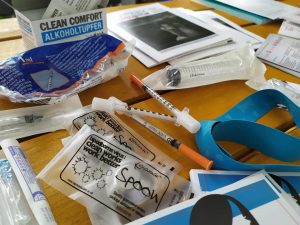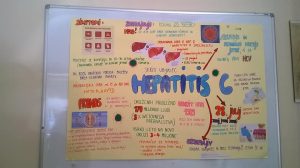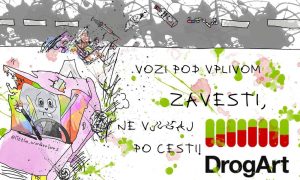| Population | 2,089,310 [1] |
| PWID | 4,853 [2] |
| OST | Available in 10 operational sites, with methadone, buprenorphine. [3] |
| NSP | Available in 102 operational sites. [3] |
| HIV | Prevalence among PWID – 1,3% [4] |
| Hepatitis C | Prevalence among PWID – 30,5% [3] |
| Hepatitis B | Prevalence among PWID – 3,4% [3] |
| Tuberculosis | |
| Overdose prevention | Naloxone is not accessible in the pharmacies at all, or without prescription, but it’s possible to get it in specialised treatment centres, specialised medical doctors’ office and any medical doctors’ office. [5] |
| HR in closed settings [6] | · OST is available in prisons. |
| Criminalization costs | · Money spent on a prisoner/per year – €29,200 [7] · Money spent on health and social services – €1050 (only unemployment benefit) [8] · Average sentence for drug law offence – up to 10 years [9] |
| Drug laws [10] | • The manufacture, trafficking, sale, and purchase of illicit drugs with the intention of sale, possession with the intent to resell, etc., of illicit drugs, banned substances in sport and precursors for illicit drugs are punishable by 1-10 years’ imprisonment, or 3-15 years if the offence involved defined aggravating circumstances, such as particular locations or the involvement of vulnerable people. • The offering of illicit drugs for consumption, the offering of premises for minors to consume illicit drugs, etc., are punishable by prison sentences of between 6 months and 8 years. Offences that involve vulnerable people or abuse of a position of trust are punishable by 1-12 years’ imprisonment. |
The overarching goal of Slovenia’s National Programme on Illicit Drugs 2014–2020 is to reduce and contain the harm of drug use on individuals, their families, and society. The Programme’s two-year Action Plans are implemented by nine ministries and with some involvement of civil society: Two NGO representatives sit on the Commission on Narcotic Drugs, the highest-level coordinating body for the National Programme’s execution.
All drug treatment programmes, confirmed by the Ministry of Health, are free of charge and are covered by the Health Insurance Institute of Slovenia. The state fully funds the purchase of equipment, cost of facilities and key staff in OAT (opioid agonist treatment) and NSP (needle and syringe program) centres but not psychosocial support. The staff in NSPs are funded by the Ministry of Labour, Family, Social Affairs and Equal Opportunities, Foundation for Funding Disability and Humanitarian Organizations and local municipalities.
Opioid agonist treatment
According to the government data, Slovenia’s substitution treatment programmes had approximately 3,300 clients in 2018 out of the estimated nearly 5,000 injecting drug users. The the Slovenian government estiamtes that the OAT coverage was at over 65% in 2019 (UNAIDS assessed that it was at 17,01% in 2016), above the World Health Organization’s recommendations to reach more than 40% of opioid-dependent people. Services are provided in 21 centres nationwide, offering methadone, buprenorphine and slow-release morphine. In 2018, the majority of clients of special treatment centres, 1,801, received methadone, 952 buprenorphine, 215 a buprenorphine/naloxone combination, and 333 slow-release morphine. Some centres provide consultations by medical doctors and psychologists to opioid or cocaine users and marijuana smokers. In 2018, a mobile unit was established for the distribution of substitution therapy.
Most new clients must come every day for their therapy, except for weekends and holidays. The rules were changed at the start of the COVID-19 pandemic, allowing people to receive substitution treatment for one week ot two weeks. The provision is planned to be reversed once the pandemic is over. Those who have been in therapy for a year and longer, yield clean drug test results and live in stable social environments, e.g., have a permanent job, may be given dosages to take home. However, the final decision depends on each OAT centre. “Some centres—like in the capital Ljubljana—follow strict protocols, allowing people to take the treatment home only after a year or so, once the right amount of therapy has been established and centres decide that the person is ready”, explained Borut Bah from Stigma, Slovenia’s Association for Harm Reduction. “Other centres start doing this after a week or two.”
Polydrug users can enter OAT programs but with some restrictions. They are also not allowed to take home the treatment and must undergo frequent tests, usually, every 14 days after testing positive for other than substitution treatment substances.
According to Borut Bah, not all people undergoing substitution treatment are allowed to drive cars in Slovenia—only those who have been in therapy for at least a year and get permission from a psychiatrist can.
Needle and syringe program
There are twelve needle and syringe program (NSP) centres in Slovenia, half of which are low threshold. Syringes and other injecting equipment are distributed in six NGO-run mobile NSPs across the country that also provide essential healthcare services and referrals. The National Institute of Public Health covers the cost of the sterile injecting supplies that it distributes to NPS centres, while the Ministry of Health, Ministry of Labour, Family, Social Affairs and Equal Opportunities, Foundation for Funding Disability and Humanitarian Organizations and local municipalities provides funding for their running. Over 590,000 syringes were distributed to 2,144 clients in 2018, an average of 275 per person. For additional services, e.g., foil for smoking heroin, harm reduction NGOs, like Stigma, finance some of their activities through other financing schemes and projects. “There are plans to start distributing sterile water for injecting”, Borut Bah said.
needle and syringe program (NSP) centres in Slovenia, half of which are low threshold. Syringes and other injecting equipment are distributed in six NGO-run mobile NSPs across the country that also provide essential healthcare services and referrals. The National Institute of Public Health covers the cost of the sterile injecting supplies that it distributes to NPS centres, while the Ministry of Health, Ministry of Labour, Family, Social Affairs and Equal Opportunities, Foundation for Funding Disability and Humanitarian Organizations and local municipalities provides funding for their running. Over 590,000 syringes were distributed to 2,144 clients in 2018, an average of 275 per person. For additional services, e.g., foil for smoking heroin, harm reduction NGOs, like Stigma, finance some of their activities through other financing schemes and projects. “There are plans to start distributing sterile water for injecting”, Borut Bah said.
“The Ministry of Labour, Family, Social Affairs and Equal Opportunities gives us money to employ social workers, but not people who use drugs”, Borut Bah added. “The three people who use drugs that are employed in Stigma are paid by the funds from Ljubljana municipality and the Bureau for Unemployment. But only for one year”.
HIV and Hep C among people who use drugs

New cases of HIV among people who use drugs are almost non-existent in Slovenia: no new cases were reported in 2017 and 2018. Testing for HIV and Hepatitis C is offered in OAT, but not in NSP centres. Slovenia has an integrated national network approach to the treatment of hepatitis C among people who use drugs, implemented with coordination between the five clinical centres for viral hepatitis treatment and the 18 drug treatment centres in the country.
Drug checking
Drug checking system in Slovenia is considered most developed in the region of Central and Eastern Europe and Central Asia. Services are primarily provided by NGO DrogArt in cooperation with the National Institute of Public Health. Drugs are collected once a week and tested in a few-days-time. Heroin, cocaine, ecstasy, and MDMA are the most often checked substances. A mobile laboratory checks drugs during festivals and other large-scale events, and reagent test kits are distributed as well. Through a network of low threshold programmes, DrogArt also collects drug samples for checking in nightlife venues and provides information in person, online or over the phone.
in Slovenia is considered most developed in the region of Central and Eastern Europe and Central Asia. Services are primarily provided by NGO DrogArt in cooperation with the National Institute of Public Health. Drugs are collected once a week and tested in a few-days-time. Heroin, cocaine, ecstasy, and MDMA are the most often checked substances. A mobile laboratory checks drugs during festivals and other large-scale events, and reagent test kits are distributed as well. Through a network of low threshold programmes, DrogArt also collects drug samples for checking in nightlife venues and provides information in person, online or over the phone.
Overdose prevention
In 2018, 59 deaths from overdose were reported in the country, an increase of 22 compared to the previous year. Naloxone is still only acceesible through medical doctors because the take-home programme has not been introduced yet, although it is mentioned in the National Programme’s Action Plan 2019-2020. According to Borut Bah, people are still somewhat afraid to call an ambulance in case of an overdose. “People often come to our centres, asking to call an ambulance, not wanting to communicate directly with authorities”, Borut Bah said.
The issue of establishing safe injection rooms was aincluded in the National Programme on Illicit Drugs 2014–2020, and steps have been taken since to make it a reality in cooperation with non-governmental organisations. Ljubljana and the Municipality of Koper are currently discussing possibilities of opening safe injection rooms.
Women who use drugs
One of the homeless shelters in the capital Ljubljana is dedicated to people who use drugs, and a safe house was established for women who use drugs and are victims of domestic and other forms of violence. But women with children are not allowed to stay there. “If a woman on substitution treatment also uses other drugs, her children can be taken away by the state if they cannot guarantee their sufficient safety,” Borut Bah explained. “Even though laws don’t explicitly say that. An NGO Kings of Street work with homeless women with children and can provide temporary shelter for them, despite their drug use. If detoxification is needed after a woman gives birth, the mother and the child can stay in the same hospital.”
Drug laws
Possession of drugs for one-time personal use is a minor offence in Slovenia, under Article 33 paragraph 1 of the Production of and Trade in Illicit Drugs Act, and is punishable by a fine between €208.64 and €625.93, while for the possession of a small amount for one-time personal use—between €41.72 and € 208.64. Perpetrators can receive a lighter penalty if they choose to enrol in state-approved treatment or social care programmes. While manufacturing, dealing, and possession in large amounts is a criminal offence, which may result in imprisonment for up to 10 years, and 15 in case of violations involving aggravating circumstances. The Probation Act that entered into force on 17 July 2017 establishes the execution of community sanctions for minor durg-related offences: suspended sentences and conditional release with probation-type supervision, community service and house imprisonment. Community service is also applied in pre-trial proceedings.
Harm reduction in prisons
Some 605 persons were included in substitution treatment in Slovenia’s prisons in 2018, primarily receiving methadone. People who have never been on a substitution treatment may start it in prison. No NSP is available in penitentiaries, but inmates may request a visit from harm reduction NGOs. “Many years ago, we were going there regularly every week, but then the prison said no,” Borut Bah recalled. “About 40% of prisoners are in for drug-related offences. Most are locked up for steeling to get them.”
Cannabis regulation
The adjustments made in 2017 to the laws regulating illicit drug use enabled prescription of cannabinoids for medical purposes in Slovenia. Medicines made from cannabis are now available in all forms and can be prescribed by doctors after the need for them is established based on medical indications. All such medications prescribed to children are financed entirely by compulsory health care insurance and require no additional payment. For adult patients, the insurance covers the full price in cases of epilepsy treatment and 70 % for treating other indications.
With gradual changes in its drug policy, Slovenia increasingly employs comprehensive and humane attitudes toward drug use, based on human rights and public health and advocating free access to programs for infection prevention, harm reduction, treatment, and social rehabilitation.
[1]https://www.stat.si/StatWeb/en
[2]http://www.emcdda.europa.eu/countries/drug-reports/2018/slovenia_en
[3]https://www.hri.global/files/2018/12/10/Eurasia-harm-reduction.pdf
[4] Ibid.
[5]http://www.emcdda.europa.eu/data/stats2019/hsr_en
[6]http://www.emcdda.europa.eu/countries/drug-reports/2018/slovenia/drug-use-and-responses-prison_en
[7]http://wp.unil.ch/space/files/2019/04/FinalReportpdf
[8]https://ec.europa.eu/social/main.jsp?catId=1128&langId=en&intPageId=4785
[9]http://www.emcdda.europa.eu/countries/drug-reports/2018/slovenia/drug-laws-and-drug-law-offences_en
[10]http://www.emcdda.europa.eu/countries/drug-reports/2019/slovenia/drug-laws-and-drug-law-offences_en
